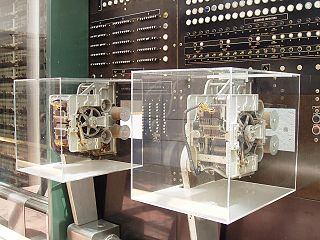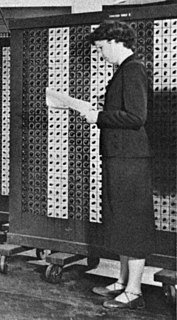Related Research Articles

William Nelson Joy is an American computer engineer and venture capitalist. He co-founded Sun Microsystems in 1982 along with Scott McNealy, Vinod Khosla, and Andy Bechtolsheim, and served as Chief Scientist and CTO at the company until 2003.

Daniel Singer Bricklin is an American businessman and engineer who is the co-creator, with Bob Frankston, of the VisiCalc spreadsheet program. He also founded Software Garden, Inc., of which he is currently president, and Trellix. which he left in 2004. He currently serves as the chief technology officer of Alpha Software.

Grace Brewster Murray Hopper was an American computer scientist and United States Navy rear admiral. One of the first programmers of the Harvard Mark I computer, she was a pioneer of computer programming who invented one of the first linkers. Hopper was the first to devise the theory of machine-independent programming languages, and the FLOW-MATIC programming language she created using this theory was later extended to create COBOL, an early high-level programming language still in use today.

John Kenneth Ousterhout is a professor of computer science at Stanford University. He founded Electric Cloud with John Graham-Cumming. Ousterhout was a professor of computer science at University of California, Berkeley where he created the Tcl scripting language and the Tk platform-independent widget toolkit, and proposed the idea of coscheduling. Ousterhout led the research group that designed the experimental Sprite operating system and the first log-structured file system. Ousterhout also led the team that developed the Magic VLSI computer-aided design (CAD) program.
Feng-hsiung Hsu is a Taiwanese-American computer scientist and the author of the book Behind Deep Blue: Building the Computer that Defeated the World Chess Champion. His work led to the creation of the Deep Thought chess computer, which led to the first chess playing computer to defeat grandmasters in tournament play and the first to achieve a certified grandmaster-level rating.

The IBM Automatic Sequence Controlled Calculator (ASCC), called Mark I by Harvard University’s staff, was a general purpose electromechanical computer that was used in the war effort during the last part of World War II.

Howard Hathaway Aiken was an American physicist and a pioneer in computing, being the original conceptual designer behind IBM's Harvard Mark I computer.

The Grace Murray Hopper Award has been awarded by the Association for Computing Machinery (ACM) since 1971. The award goes to a computer professional who makes a single, significant technical or service contribution at or before age 35.

Roger D. Moore was the 1973 recipient of the Grace Murray Hopper Award from the Association for Computing Machinery (ACM). It was given "for their work in the design and implementation of APL\360, setting new standards in simplicity, efficiency, reliability and response time for interactive systems."

Grace Hopper College is a residential college of Yale University, opened in 1933 as one of the original eight undergraduate residential colleges endowed by Edward Harkness. It was originally named Calhoun College after US Vice President John C. Calhoun, but renamed in 2017 in honor of computer scientist Grace Murray Hopper. The building was designed by John Russell Pope.

Daniel Henry Holmes Ingalls Jr. is a pioneer of object-oriented computer programming and the principal architect, designer and implementer of five generations of Smalltalk environments. He designed the bytecoded virtual machine that made Smalltalk practical in 1976. He also invented bit blit, the general-purpose graphical operation that underlies most bitmap computer graphics systems today, and pop-up menus. He designed the generalizations of BitBlt to arbitrary color depth, with built-in scaling, rotation, and anti-aliasing. He made major contributions to the Squeak version of Smalltalk, including the original concept of a Smalltalk written in itself and made portable and efficient by a Smalltalk-to-C translator.
The Eckert–Mauchly Computer Corporation (EMCC) was founded by J. Presper Eckert and John Mauchly. It was incorporated on December 22, 1947. After building the ENIAC at the University of Pennsylvania, Eckert and Mauchly formed EMCC to build new computer designs for commercial and military applications. The company was initially called the Electronic Control Company, changing its name to Eckert–Mauchly Computer Corporation when it was incorporated. In 1950, the company was sold to Remington Rand, which later merged with Sperry Corporation to become Sperry Rand, and survives today as Unisys.
Jean E. Sammet was an American computer scientist who developed the FORMAC programming language in 1962. She was also one of the developers of the influential COBOL programming language.

Frances Elizabeth Holberton was an American computer scientist who was one of the six original programmers of the first general-purpose electronic digital computer, ENIAC. The other five ENIAC programmers were Jean Bartik, Ruth Teitelbaum, Kathleen Antonelli, Marlyn Meltzer, and Frances Spence.
The Grace Hopper Celebration of Women in Computing (GHC) is a series of conferences designed to bring the research and career interests of women in computing to the forefront. It is the world's largest gathering of women in computing. The celebration, named after computer scientist Grace Hopper, is organized by the Anita Borg Institute for Women and Technology and the Association for Computing Machinery. The 2020 conference was held virtually at the end of September 2020 due to the coronavirus pandemic.
Lydia E. Kavraki is a Greek-American computer scientist, the Noah Harding Professor of Computer Science, a professor of bioengineering, electrical and computer engineering, and mechanical engineering at Rice University. She is also the director of the Ken Kennedy Institute at Rice University. She is known for her work on robotics/AI and bioinformatics/computational biology and in particular for the probabilistic roadmap method for robot motion planning and biomolecular configuration analysis.

The Association for Computing Machinery's Council on Women in Computing (ACM-W) supports, celebrates, and advocates internationally for the full engagement of women in all aspects of the computing field, providing a wide range of programs and services to ACM members and working in the larger community to advance the contributions of technical women. ACM-W is an active organization with over 36,000 members.

Adele Mildred Koss, known as Milly Koss, was an American computing pioneer. The Association for Women in Computing awarded her an Ada Lovelace Award in 2000.
Allan L. Scherr is an American computer scientist notable for his work in time-sharing operating systems and leading the original development of the IBM MVS operating system, used on IBM mainframe computers.
Richard Milton Bloch was a pioneering American computer programmer. Bloch, Grace Hopper, and Robert Campbell were the first programmers of the Harvard Mark I, an electromechanical computer which, when it began operation in 1944, was the first American programmable computer.
References
- ↑ Williams, Kathleen (2012). Grace Hopper: Admiral of the Cyber Sea. Naval Institute Press. p. 131. ISBN 9781612512655.
- ↑ "George N. Baird". awards.acm.org. Association for Computing Machinery.